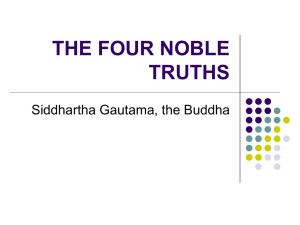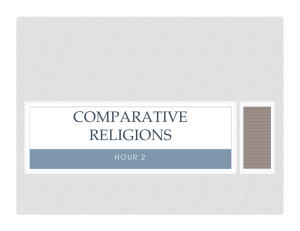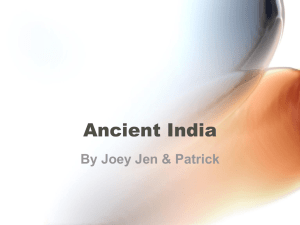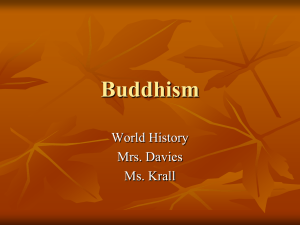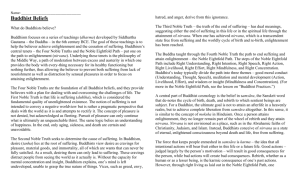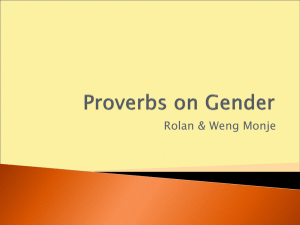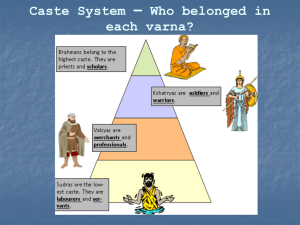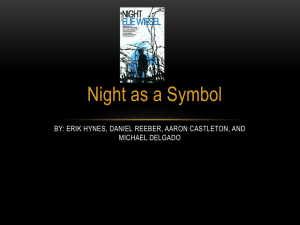Lesson 5 - Castlemilk High School
advertisement
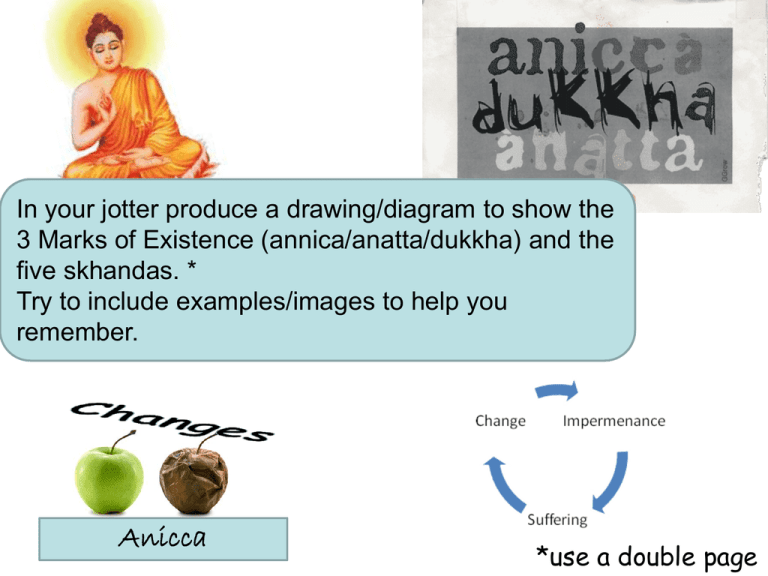
In your jotter produce a drawing/diagram to show the 3 Marks of Existence (annica/anatta/dukkha) and the five skhandas. * Try to include examples/images to help you remember. Anicca *use a double page The Four Noble Truths After Enlightenment After the Buddha achieved enlightenment (Nibbana), he spent the rest of his life teaching others about what he had learned. The Buddha lived until the age of about 80. He also guided others as to how they could also achieve enlightenment. When the Buddha achieved enlightenment he gained an understanding of truths about the nature of reality and the nature of humans. Part of this understanding can be seen in the “3 Marks of Existence” It can also be seen in the: 4 Noble Truths These truths are a fundamental part of Buddhist teaching and not only describe why people suffer, but point Buddhists in the direction of an end to suffering. What Are The Four Noble Truths? The First - Dukkha The Second - Samudaya The Third - Nirodha The Fourth - Magga 1st Noble Truth Buddha taught that suffering (Dukkha) was real and happens all the time. Siddhartha saw the first 3 sights and this showed him suffering was everywhere. He saw different ways of suffering but he still said it was all similar. Suffering happens all the time in our lives, sometimes we don’t even realise it. Happiness is just temporary for us, we are never happy for very long. Activity Would suffering exist if you could never be happy? Do you find this pessimistic? Optimistic? Truthful? Something else? Why do you think this? 2nd Noble Truth The second noble truth is that suffering has a cause. Buddha said that the real cause of all suffering was desire or wanting something. He said there were 3 ways this could happen: 1.Desire for a thing. Greed. Eg wanting a new phone 2.Not knowing the truth (the 4 noble truths). Ignorance. Eg. Wanting cake because you think it will make you happy. 3.Wanting bad things for others not you. Hate. Eg wanting someone else to suffer He sometimes called these the “3 fires”. Even when the suffering appears to be caused my something outside of us Buddha said it is our minds reaction that makes us suffer. Activity Draw a symbol which represents each of the 3 fires. Give an example of one of the fires from your own life. 3rd Noble Truth The third noble truth says that you can avoid suffering and reach a point where you never suffer and you have an everlasting happiness. This is called Nibbana. Buddha did not say much about Nirvana other than it made you care about other people more, and you did not suffer. Buddha is an example of someone who achieved Nibbana. Buddha wanted to show that this was possible in everyday life so that life did not seem so sad as it was filled with suffering. Activity What does Nirvana feel like? Draw or write some of your own ideas. Why would you want to achieve Nirvana 4th Noble Truth The 4th Noble truth is instructions on how to avoid suffering. It says that you need to avoid the two extremes. Siddhartha avoided the extremes of having too much (as a prince) and having not enough (as a holy man in the forest) by finding balance between them. He called this the middle way. It is a bit like balancing a seesaw He suggested following a system called the 8 fold path which was the middle way. We will learn more about this next lesson Avoiding suffering involves avoiding desire and cravings. This is like a smoker who avoids smoking by getting rid of their cigarette cravings. Activity Can we control our desires? Why? Give an example of something which avoids two extremes. Give an example of a time you have avoided a desire. The First Noble Truth - Dukkha Life Is Suffering The Second Noble Truth - Samudaya Suffering Is Caused by Desire The Third Noble Truth - Nirodha To Stop Suffering You Have To Stop Desiring The Fourth Noble Truth - Magga To Stop Desiring Follow the EightFold Path asdfasdfs adfasdfas dfsadfsad fsadfsadf sadfsadfs adfsadfsa dfsadfasd fasdfsadf asdfasdfa The Story of Kisagotami Kisagotami had a young son who was bitten by a snake and died. Kisagotami could not accept that he was actually dead. She went to see the Buddha to see if he could help her son. The Buddha told her to bring back one grain of mustard seed from a house that has not experienced a death in the family. The Story of Kisagotami Kisagotami went off and tried to do this, but she could not. Everywhere she went, families had suffered losses of life. She realised that everyone had experienced the suffering of losing a loved one. Questions 1. Do you agree with the first noble truth? What evidence is their to support your view? (2 Marks) 2. Describe and explain the meaning behind the story of Kisagotami. ( 4 Marks) 3. What are the four noble truths? (4 Marks) 4. Why are the 4 Noble truths so important to the Buddhist understanding of the human condition? (2 Marks) 5. “It’s impossible to stop desiring, so the Four Noble Truths can’t teach you how to stop suffering”. Do you agree with this statement? (3 Marks)
